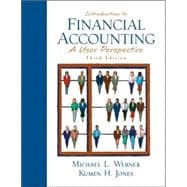
| Introduction To Business In The United States | |
| Introduction To Decision Making | |
| Economic Decision Making And Useful Accounting Information | |
| Tools Of The Trade | |
| The Balance Sheet: Initial Financing-Investment Buy Owners | |
| The Balance Sheet (Continued): Additional Financing- Borrowing From Others | |
| Tools Of The Trade | |
| Income Statement And Statement Of Owners' Equity | |
| Keeping Score: Bases of Economic Measurement | |
| Challenging Issues Under Accrual Accounting: Long-Lived Depreciable Assets-A Close Look | |
| Challenging Issues Under Accrual Accounting: Merchandise Inventory And Cost Of Goods Sold | |
| The Balance Sheet And Income Statement: A Closer Look | |
| Tools Of The Trade | |
| The Statement Of Cash Flows: Bringing The Focus Back To Cash | |
| Generally Accepted Accounting Principles And Forms Of Outside Assurance On Financial Statements | |
| Financial Reporting: The Annual Report And The Form 10-K | |
| Financial Statement Analysis | |
| Appendix | |
| Glossary | |
| Index | |
| Table of Contents provided by Publisher. All Rights Reserved. |
The New copy of this book will include any supplemental materials advertised. Please check the title of the book to determine if it should include any access cards, study guides, lab manuals, CDs, etc.
The Used, Rental and eBook copies of this book are not guaranteed to include any supplemental materials. Typically, only the book itself is included. This is true even if the title states it includes any access cards, study guides, lab manuals, CDs, etc.